HOME | REVIEWS: A-Z | FURTHER READING | NEWS | ABOUT
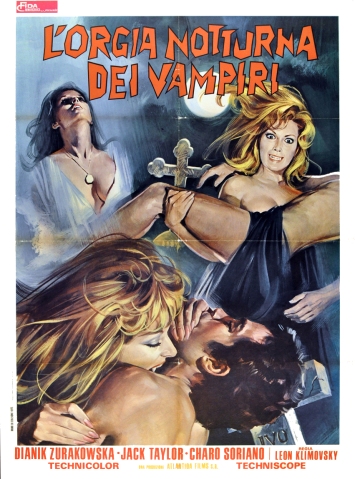
The Vampires’ Night Orgy
1973 / Colour / 84 m. / Spain/Italy / La orgía nocturna de los vampiros
Starring: Jack Taylor, Dianik Zurakowska, Jose Guardiola, Charo Soriano, Helga Line, Manuel de Blas, David Aller, Luis Ciges, Indio Gonzalez, Fernando Bilbao
Cinematography: Antonio Lopez Ballesteros
Production Designer: Gumersindo Andres
Film Editor: Antonio Ramirez de Loaysa
Written by: Gabriel Burgos and Antonio Fos
Produced by: Jose Frade
Directed by: Leon Klimovsky
Reviewed by Lee Broughton
Synopsis:
A motley collection of support workers are en route to new employment positions at a remote country estate in Spain when the driver of their bus is taken ill. They are forced to take a detour and come across an uncharted village called Tolnia where they meet a lost traveller called Luis (Jack Taylor). The village is deserted but the hotel has been readied for guests, so the weary travellers decide to stay the night. The next morning, the hotel is buzzing with friendly locals who extend further hospitality to the group when it is discovered that both their coach and Luis’ car have developed mechanical faults. However, it soon becomes apparent that the village is populated by vampires who intend picking the travellers off one by one.
Critique:
After previously noting the seemingly rushed and uneven quality of parts of Leon Klimovsky’s Dr Jekyll vs the Werewolf (1972), it’s something of a pleasant surprise to find the director displaying a more consistent approach here. Although The Vampires’ Night Orgy is a reasonably low budget affair it succeeds in being quite stylish in its presentation, boasting solid camera placements and fluid camera moves, a succession of well composed shots and virtually inch perfect framing throughout. Maybe the presence of veteran cinematographer Antonio L. Ballesteros, who shot both The Last Days of Pompeii (1959) and The Colossus of Rhodes (1961) for Sergio Leone, helped Klimovsky to up his game a little.
Either way, Klimovsky has put together an effective and atmospheric little fright film here that manages to successfully combine two distinct strands of the European vampire mythos. Actual historical accounts of vampirism in Europe tend to feature feral and monstrous vampires who stem mostly from the lower social classes of rural regions. These vampires are former farm labourers and peasants and most of the vampires seen in The Vampires’ Night Orgy are coded in this way. It was European gothic literature that introduced the idea of the aristocratic vampire and The Vampires’ Night Orgy includes a nod to this popular tradition too via its incorporation of Helga Line’s bloodsucking Countess.
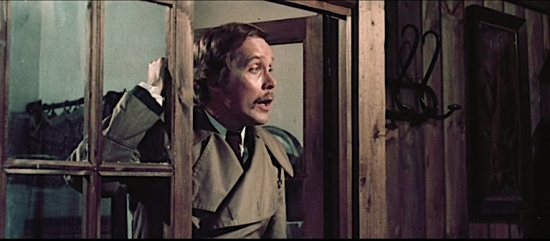
While the Countess is clearly the most powerful vampire in Tolnia, she stays in the background and allows the town’s civic leader, the Major (Jose Guardiola), to oversee the communal conspiracy that is designed to entrap the travellers. Tolnia’s isolated location within the Spanish countryside, the insidious communal conspiracy that the town’s inhabitants knowingly involve themselves in and the Lord Summerisle-like authority that is bestowed upon the Major all combine to conjure up an oppressive air that is wholly similar to that of Robin Hardy’s classic folk horror film The Wicker Man (1973).
Klimovsky and his crew conjure up a number of genuinely creepy and disturbing scenes here. An early sequence, wherein the ominous creak of the hotel’s front door being opened by unseen hands at midnight prompts Ernest (Indio Gonzalez) to begin exploring Tolnia’s deserted streets, is right up there with the best suspense-cum-scare scenes of the genre: it’s real edge of the seat stuff. And a scene where the Countess slowly emerges from her tomb in order to attack one of the female travellers, who is foolishly wandering around the labyrinthine tunnels that run beneath the hotel, is also pretty effective.
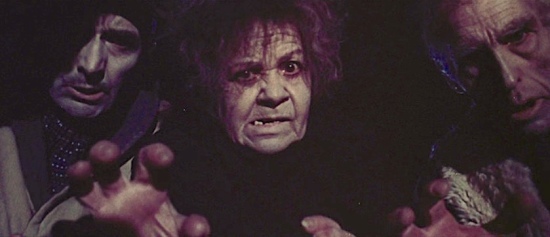
The film’s vampire attack sequences are generally quite scary too. With the exception of the Countess, the vampires hunt in packs, silently emerging from shadowy areas and shuffling along the town’s quiet streets like zombies until they converge to collectively corner and overcome their victims. During these suspenseful scenes, Klimovsky chooses to generate fear through imaginative staging and suggestion rather than resorting to any gory excesses. These scenes are also enhanced by some really effective and atmospheric synthesiser-led music cues.
In other sections of the film Klimovsky’s noticeably determined efforts to present some totally original genre scenarios do ultimately result in some particularly unpleasant and ghoulishly macabre ideas being played out on screen. For example, when meat is needed for the travellers’ meals, the Countess instructs her axeman (Fernando Bilbao) to obtain it from a rather unorthodox source. And a sickly nod towards an EC Comics’ Vault of Horror story (which subsequently appeared as an episode in Roy Ward Baker’s Vault of Horror [1973] film) can be found when the Major is pressed to join his guests for a drink in the hotel bar and opts to partake of the contents of a special bottle.
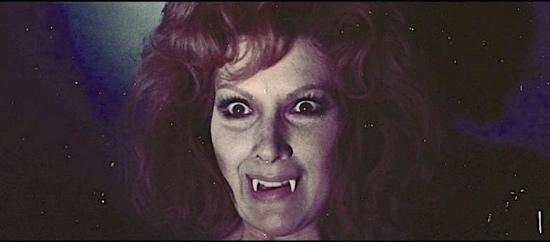
The nearest point of reference for Klimovsky’s film might well be the unsettling episode from Roy Ward Baker’s The Monster Club (1981) that starred Stuart Whitman. Indeed, there are some key similarities between the two stories. So much so that, when two cops appear at the end of The Vampires’ Night Orgy, we spend the last five minutes of the film on tenter hooks wondering whether this tale of unfortunate travellers trying to escape from a strange rural village is going to end with the same shocking twist as the Monster Club story.
Euro-cult stalwarts Jack Taylor, Helga Line and Fernando Bilbao are as reliable as ever in their roles as Luis, the Countess and her axeman but the whole show is well acted, with all of the travellers being successfully presented as fairly full and well defined characters. They’re a diverse enough bunch to be suitably interesting and involving and the tragic ends that most of them meet do pack a noticeably emotional punch.
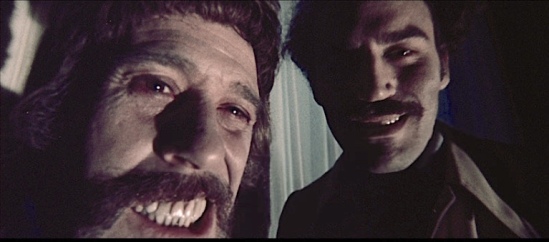
The film’s soundtrack score is a bit of a mixed bag, with all of the music having seemingly been sourced from the Ediciones Phonorecord music library. The music itself is generally very good, and some of the selections are used in particularly effective ways. However, other selections play somewhat incongruously and their use adversely affects a couple of sections of the film a little.
This show isn’t quite perfect but, of all of the films that have attempted to place elements of the vampire mythos within a modern day setting, The Vampires’ Night Orgy must surely rank as one of the best and most original efforts.
Psychotronic Cinemas rating: Very Good
CODA (features spoilers)
In 2017 I gave a talk about The Vampires’ Night Orgy at that year’s Cine-Excess conference. I discussed the film’s folk horror aspects while also exploring the specifically Spanish modes of cultural production, and the local cultural and political concerns, that might be found within the film.
In terms of the latter strand of enquiry, Nicholas G. Schlegel has argued that the essence of the traumas and the horrors that the Spanish people suffered during the country’s civil war and the years of the Franco dictatorship that followed it are sometimes manifested (be it consciously or subconsciously) as allegorical or symbolic resonances in the horror films that were produced in Spain between the late 1960s and the mid 1970s.
I set out to determine whether Schlegel’s assertions might apply to The Vampires’ Night Orgy. Posting this review is a good opportunity for me to offer a few short examples of the related resonances that my research detected within the film.
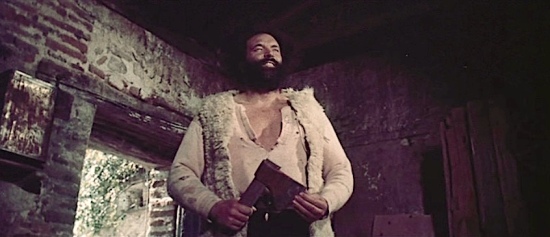
The 1940s in Spain were known as ‘the Years of Hunger’ and over 200,000 people died of starvation in the country during that decade. Clearly a whole generation of Spaniards knew how it felt to be on the verge of starvation and they had to force themselves to eat highly unpalatable foodstuffs in order to survive. Interestingly, The Vampires’ Night Orgy features a number of pointed scenarios that revolve around hunger and the eating of unpalatable foodstuffs.
The vampires here know hunger since they are reduced to sharing their limited number of victims. Indeed, the film features unusual scenes wherein several vampires are seen simultaneously feeding from the body of just one victim (similar scenarios are also found in the Spanish director Joseph Larraz’s Vampyres [1974]).
The travellers know hunger too. They are hungry when they arrive in Tolnia and meat is needed to prepare hearty dinners for them while also serving to give the town an air of normality. However, this meat is sourced by the Countess’ axeman, who obtains it by chopping limbs off of the bodies of the town’s hapless peasant classes. When one of the travellers finds a severed finger in their meal and the true nature of the meat that they have been consuming becomes apparent to them, the act of eating the unpalatable is symbolically evoked in a determinedly grotesque manner.
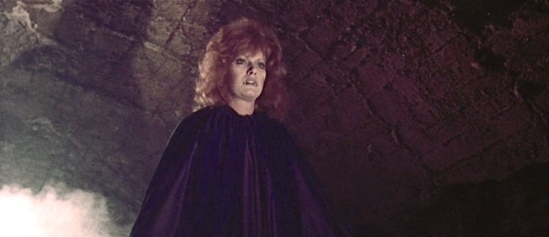
Another ongoing legacy of the Spanish Civil War and Franco’s rise to power is that of ‘the disappeared’ or ‘the vanished.’ Franco’s nationalist forces were quick to dispose of their political enemies and other dissenters and it is estimated that more than half a million people simply vanished from within Spain between 1939 and 1945. The Vampires’ Night Orgy features numerous scenes in which the act of disappearing or vanishing is made literal. Seven people enter Tolnia but five of them disappear and only two of them manage to leave. More significantly, when the two escapees return later with the police, the town and its vampiric occupants have themselves completely vanished without a trace or an explanation.
Finally, it’s interesting to note that the film’s power dynamics are very much those of a dictatorship. The Countess has absolute power and her deputies (the Major, the axeman and so on) have the authority and the ideological will to carry out her every order, no matter how heinous that order might be.
© Copyright 2002, 2017, 2020 Lee Broughton.
HOME | REVIEWS: A-Z | FURTHER READING | NEWS | ABOUT
You must be logged in to post a comment.